Artist, portraitist and illustrator Charles Lewis Wrenn was born 18 Sep 1880 in Cincinnati, Ohio, and died 28 Oct 1952 in Norwalk, Fairfield, Connecticut.
He painted several watercolors at Lake Chapala, including some in Ajijic in 1943, though the precise dates of his visit or visits to the area are currently unknown. This watercolor of fishermen tending their nets is typical of his work; it is almost identical to another watercolor dated 1943, presumably painted at the same time:
Wrenn’s choice of subject matter at Lake Chapala included some relatively rarely painted scenes, such as this lovely painting of a ruined building on historic Mezcala Island:
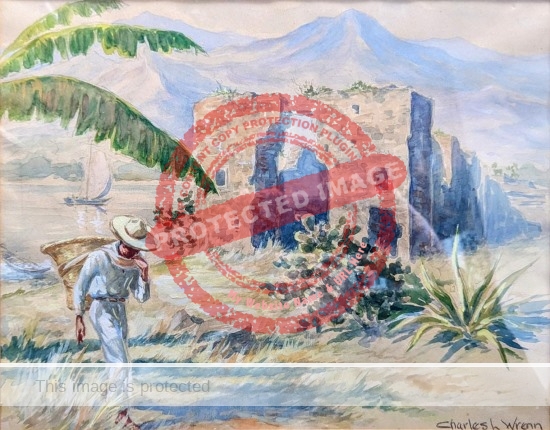
Charles L. Wrenn. c 1943. “Old Prison at Lake Chapala.” (Reproduced by kind permission of Allen Bourne)
This gloomier watercolor, entitled “Water Carrier, Lake Chapala” was for sale on eBay in November 2015:
And this charming Ajijic watercolor, dated 1943, with its obvious illustrator influence, was for sale on eBay in 2024:
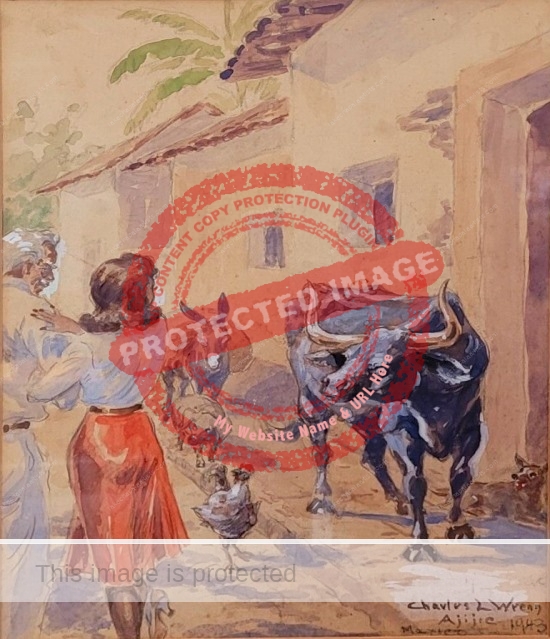
Charles L. Wrenn. 1943. Ajijic, Mexico. (eBay, March 2024)
In about 1900 (when he was about 20 years old) Wrenn moved to New York City and lived in Manhattan. After graduating from Princeton in the class of 1903, he immersed himself in art, studying at The Art Students League, and with the impressionist painter William Merritt Chase (1849-1916). On 5 October 1907 he married Helen Gibbs Bourne of New Jersey, and they moved to 364 West 23rd Street; his art studio was at 9 East 10th Street. The couple later moved to Wilson Point, Norwalk, where Charles (“Charlie”) had his studio in the loft of his red barn.
In 1914, Wrenn wrote that, “My ten years since graduation have been devoted to ART. After a year at the Art Students’ League and The New York Art School, I took up the illustrating branch and have been following it ever since.” From 1911 to 1917 he drew illustrations for stories in The Red Book Magazine, People’s Home Journal, and The Housewife. He also painted cover illustrations for the pulp magazine Breezy Stories.
Wrenn illustrated numerous books, including: Molly Brown’s Sophomore Days by Nell Speed (1912); The Boy Scouts at the Panama Canal (1913) and Boy Scouts under Sealed Orders (1916), both by Howard Payson; Uncle Noah’s Christmas Inspiration (1914) by Leona Dalrymple; Guns of Europe (1915), Tree of Appomattox (1916), Hosts of the Air (1915), The Great Sioux Trail (1918), The Sun of Quebec: A Story of a Great Crisis (1919), all by Joseph A. Altsheler; Polly’s Senior Year at Boarding School (1917) by Dorothy Whitehill; Boy Scouts Afloat (1917) by Walter Walden; and For the Freedom of the Seas (1918) by Ralph Henry Barbour.
In 1918, at age thirty-eight, he was not accepted for military service in WWI, so he applied for a passport and went to France for one year as a citizen volunteer for the Red Cross, working as a stretcher bearer. His passport describes him as 5′ 10½”, blue eyes, grey hair, thin face, with a Roman nose and a scar on his right thumb. He listed his occupation as “artist”.
After the Great War ended in 1919 he traveled to study art in Morocco, Italy, France, Spain, Portugal, Gibraltar, Tunis, Egypt, and Great Britain. He returned to the U.S. in September of 1920. He returned to Europe in 1922, this time accompanied by his wife and his mother. They returned from Palermo, Italy aboard the “Providence”.
In 1929, he visited Haiti and in 1931 Bermuda.
From 1920 to 1936 he sold freelance pulp magazine covers to The Danger Trail, People’s Magazine, Ranch Romances, Three Star Magazine, and War Stories. He also drew interior story illustrations for Clues.
In 1936 he moved to Wilson Point, South Norwalk, in Fairfield, Connecticut, where he painted portraits and landscapes for the remainder of his life. Wrenn was a member of The Society of Illustrators and specialized in painting portraits and landscapes. He painted in many parts of the U.S. including the Catskill Mountains, California, and Walpi Mesa in Arizona.
After spending time in Mexico in the early 1940s, Wrenn held “a small exhibition of his Mexican water colors” at Loring Andrews gallery in Cincinnati in June 1946. According to the Cincinnati Enquirer, besides paintings of Pátzcuaro and elsewhere, “His subject matter varies from the paintings of the strange narrow streets to the old houses of the natives of Lake Chapala.”
Wrenn and his wife visited Europe in 1952, returning only four months before his death.
Several chapters of Foreign Footprints in Ajijic: Decades of Change in a Mexican Village offer more details about the history of the artistic community in Ajijic.
Source
- The Cincinnati Enquirer: 16 June 1946, 74.
This post was updated on 12 November 2015, and on 30 March 2024.
Comments, corrections or additional material welcome, whether via comments or email.
Tony Burton’s books include “Lake Chapala: A Postcard History” (2022), “Foreign Footprints in Ajijic” (2022), “If Walls Could Talk: Chapala’s historic buildings and their former occupants” (2020), (available in translation as “Si Las Paredes Hablaran”), “Mexican Kaleidoscope” (2016), and “Lake Chapala Through the Ages” (2008).

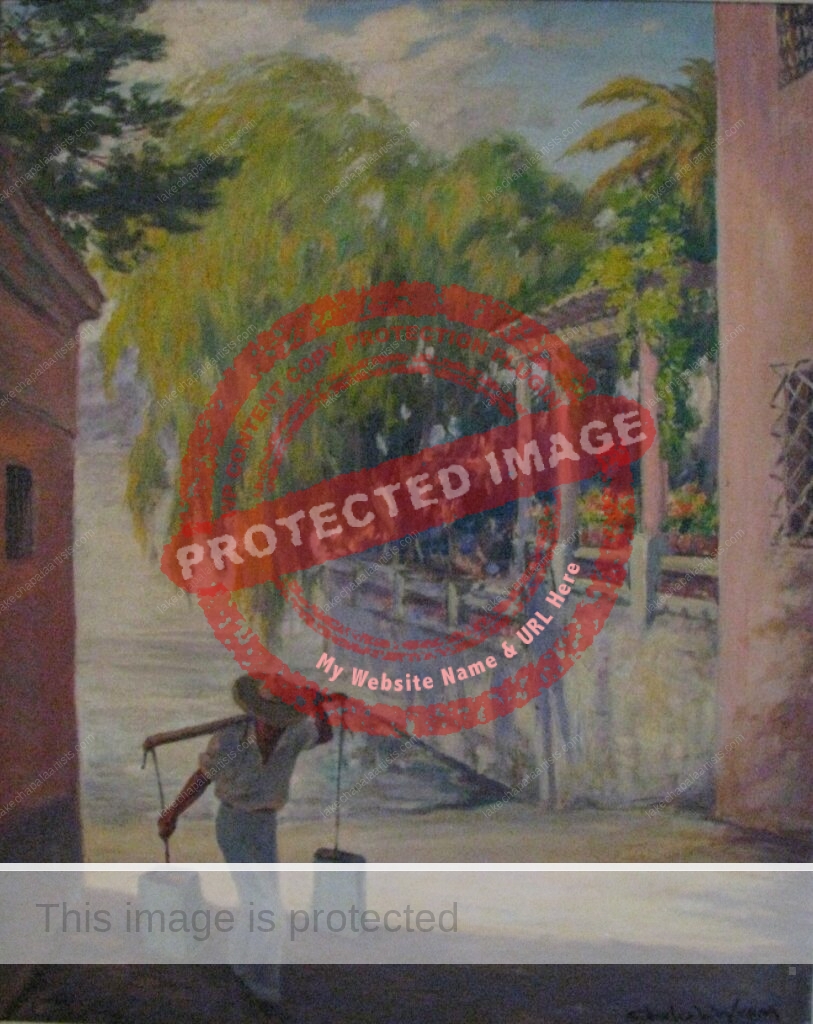
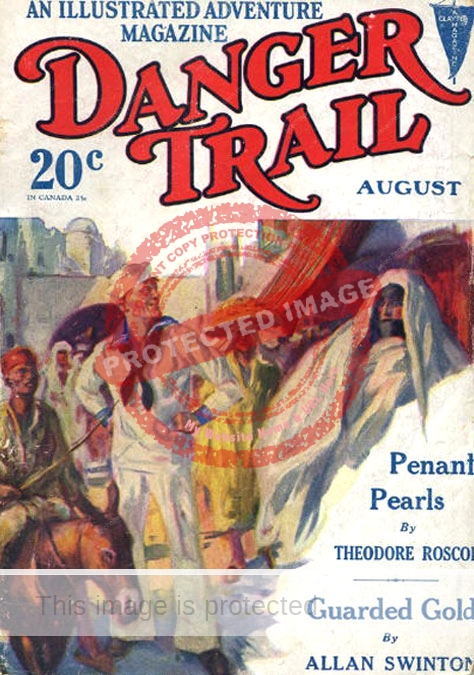
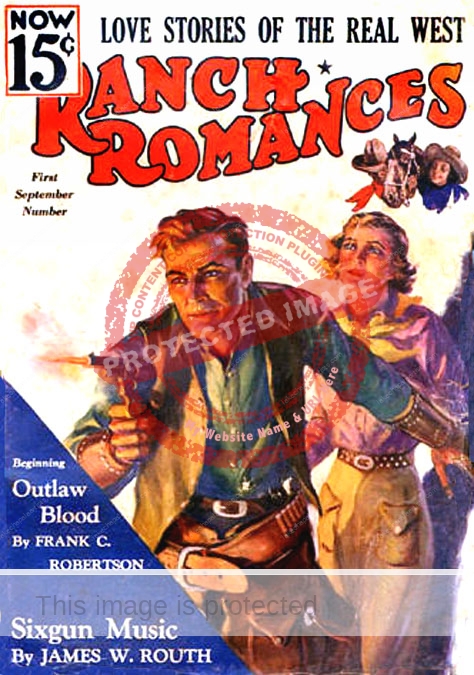
I have a bronze sculpture of a cowboy taking down a long horn steer that was given to my grandfather. The inscription on it reads, ” cowboy stories / range land stories / ace high magazine range romances “. Charles L Wrenn. It is approx. 15″ x 10” You did not mention that he was a sculptor.
Thanks for that valuable clarification and additional information. I did not know that and wonder how many other sculptures he made. Hope you continue to enjoy reading the series of bios of artists associated with the Lake Chapala area.
This sculpture was done in the late 1920’s, and was produced by the Clayton pulp chain as Christmas gifts to various of their authors and staff. I have a few copies of this that I’ve acquired through the years of collecting pulp ephemera, and they’re very cool indeed! I suspect that other pulp publishers may have done similar Christmas gifts, but I’ve not found any.
I have three watercolors by Charles L. Wrenn painted in Mexico. He was acquainted with my parents who lived in Wilson Point, CT. I was a very young child at the time but the family lore had it that he painted in the barn on my parents’ property and used it as his studio. Evidently he traded his paintings for the studio space. I have more to the story which I don’t want to go into here. I would be very interested in any information which anyone could share with me about this artist and the worth of his paintings today.
Thanks, Laurie, for your informative comment. I’ve not yet managed to pinpoint the time frame when Wrenn visited Mexico (and Lake Chapala) but still hope to find more evidence eventually!
Years old, I know, but I just saw your comment. My husband’s family also lived on Wilson Point and were good friends of Charles Wren. We have several of his paintings. Would love to chat offline
I have a painting in my home by Charles Wrenn. I’m not sure it was painted in Lake Chapala, but the scene is of a tropical lifestyle. The painting came from my grandfather’s house. My grandfather was Wyatt Blassingame, a pulp fiction writer, and Charles Wrenn illustrated the covers of some of the magazines my grandfather wrote for. I am guessing they knew each other. Do you know of someone who could tell me more about the painting? I can send pictures.
Apologies for not noticing your comment earlier; somehow it escaped my attention! Thanks for getting in touch. I’ve heard of your grandfather’s connection to Wrenn and have always assumed they were likely to be or have become quite good friends. I’d love to see photos of the painting if that’s still possible? Please send them as attachments to infoATsombrerobooks.com. If I can tell you any more about the painting, I will gladly do so. Thanks again for reaching out, TB.
Natanya, Just found this thread, as I was searching Wrenn. I have a few copies of that one sculpture by him, as well as some paintings. I’m amazed to hear that your grandfather was Wyatt Blassingame! I’m a big pulp fan (I co-run the Windy City Pulp and Paper Convention) and he’s well remembered by pulp fans. If you can post an image of the painting, I may be able to identify it for you. I’d also be interested in info on Blassingame, as I’m always looking for info on the old pulp authors. My email is pulpvaultATmsnDOTcom. Best, Doug Ellis
Interesting reading some of the comments here. I, too, inherited a Charles Wrenn watercolor painting (Mexico scene with some sort of ruin and person carrying water) and the Ace High magazine sculpture, though I’m not sure how my grandparents came by these pieces. Would love to get an idea of what these pieces are worth.
Thanks for getting in touch. It’s great to know that Wrenn’s work is still appreciated and passing down the generations. As to value, sorry, but I am completely unqualified to offer any opinion. Works by Wrenn do (occasionally) come up for auction, so you may wish to try contacting a reputable local art dealer for advice.
I co-run the Windy City Pulp and Paper Convention and have a large collection of pulp art (I collect it as well as occasionally deal in it). I co-wrote a book on pulp art a few years ago, The Art of the Pulps. If you’d like to send images, I can let you know if I can ID any of the paintings and give you a sense of their worth.
He did a watercolor and 3 ink illustrations for the book – The Girl Aviators’ Motor Butterfly by Margaret Burnham, published by Hurst & Co. in 1912. There were 4 or more, books in that series, perhaps he did them all. I just happened to buy that one today.
Thanks for taking the time to comment. Enjoy your great find! TB.